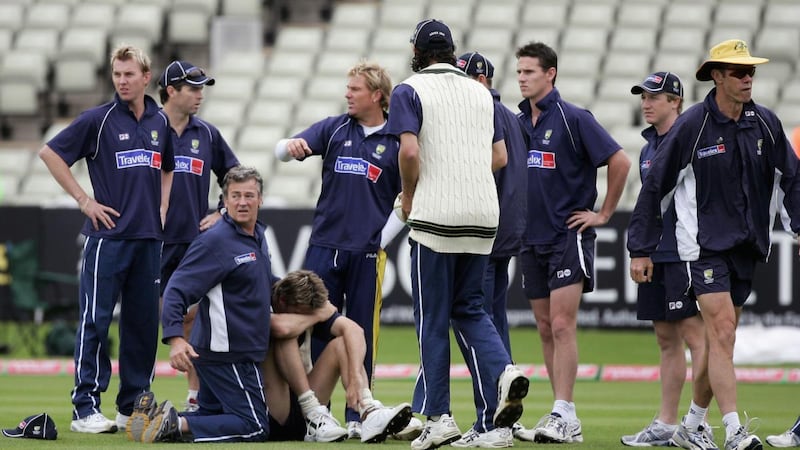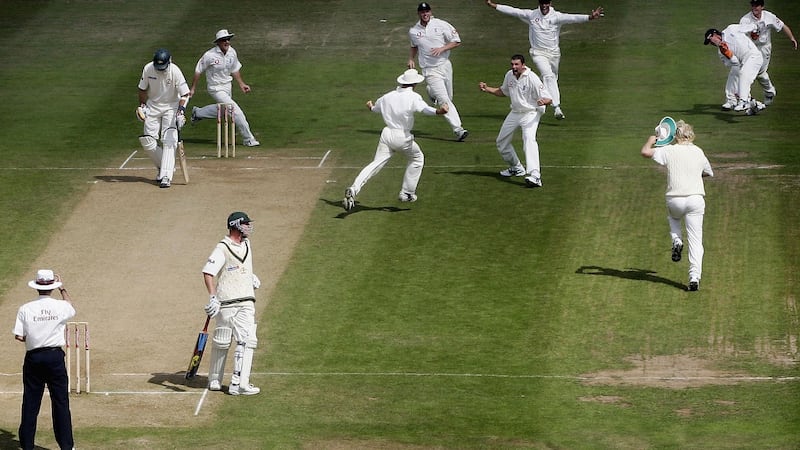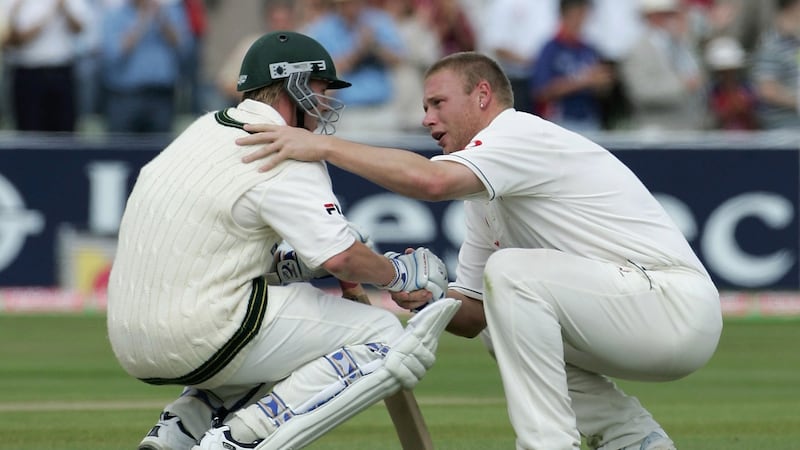Picking a favourite sporting moment is a difficult task. Picking a favourite moment from the 2005 Ashes series, when England beat Australia for the first time since 1987, is almost as tricky.
The 2005 series was a 12-week, five-Test epic. It ebbed and flowed and fizzed and roared from the moment the Aussies stepped off the plane on June 6th until England had finally regained the urn deep into September.
Like 1981 and 2019, it was a generational summer for English cricket. And every single ball was shown live on terrestrial television. For a 13-year-old already obsessed with the game, these were halcyon days, never to be seen again – quite literally, with cricket later being lost behind a Sky Sports paywall.
Growing up and falling in love with cricket during the 1990s and early 2000s, you were used to England being perennially rubbish with Australia the game’s dominant force.
Eight-consecutive series victories home and away – during which time England managed to win seven and lose 28 Test matches out of 43 – had seen Australia turn one of sport’s great rivalries into a biennial beating.
The 2002-3 series is the first one I can really remember Down Under, and it had been a dismal one for England. Nasser Hussain won the toss ahead of the first Test at The Gabba in Brisbane and invited Australia to bat. The hosts duly posted a score of 492.
The highlights, on at tea-time back at home, made for grim viewing. I can still vividly see our young fast bowler Simon Jones crumple in a heap as he chased a ball to the boundary.
He’d caught his knee in the unforgiving Brisbane turf and ruptured ligaments, before being stretchered off in front of a baying Gabbatoir crowd. We’d been beaten mentally on day one and would lose the series 4-1. Would it always be like this?
If there were any positives to take away from that desperate winter Down Under, it was the batting of Michael Vaughan, who weighed in with three centuries and was a joy to watch – his red Gunn & Moore Purist swishing and pulling and cutting in vibrant defiance.
Hussain would step down the following summer after a 2-2 draw with South Africa. Vaughan took over as skipper and along with coach Duncan Fletcher helped build the first great England side of my lifetime.
When Australia arrived in England in 2005 they were world number one. But the hosts were now second after taking five successive series, learning a winning habit while steadily rebuilding and evolving as a team.
Comforting soundtrack
By the time the series started, England were ready. It was a new-look firebrand side, with Andrew Flintoff – my cricketing hero – at its beating heart. Only four players who finished the 2002-03 Ashes series started in 2005. Fewer memories, fewer scars.
The first Test began on Thursday, July 21st, exactly two weeks on from the July 7th London bombings which had killed 66 people. Play was underway on the Thursday when there were further, failed explosions on the underground.
But in the background – reassuringly – the cricket continued. The comforting soundtrack and timeline to any English summer.
Australia won the toss on that opening day at Lord's and opted to bat first. I can still hear the ball thudding into Justin Langer and the helmet of Ricky Ponting, as Steve Harmison set the tone for the weeks to come with a brutally quick opening spell.
He took 5-43 as Australia were skittled for 190 in 40.2 overs. But then Glenn McGrath – England’s tormentor-in-chief for a decade – came in and England were bowled out for 155.
Two swashbuckling half-centuries by Test match debutant Kevin Pietersen aside, England capitulated at Lord's. Australia won the first Test by 239 runs. The same as it ever was.
The series moved onto Edgbaston. If Australia won the second Test, they'd be one draw away from retaining the Ashes. My Nan, Grandad and I, members at Lancashire, had tickets for the third Test match at Old Trafford. Added incentive – if it was needed – to not go 2-0 down in Birmingham.
By this stage of the summer we were into August, and with the second Test approaching Mum and Dad had decided, quite unreasonably, they couldn't leave a 13-year-old to his own devices for two weeks. I'd have to watch the greatest ever Test unfold on our summer holidays in Co Mayo.
Luckily for all parties involved, the small box television in the corner of the front room where we were staying was able to pick up Channel 4. I set up camp by the window, armed with a radio tuned into Test Match Special, just in case the unthinkable happen and I was stumped by a flimsy aerial.
The first drama began before a ball had been bowled. McGrath, who took nine wickets at Lord's, stood on a stray cricket ball while warming up playing rugby. He was out of the Test and replaced by Michael Kasprowicz. First blood to England – it was time to believe again.

Aggressive response
Australia captain Ponting then won the toss and asked England to bat. Marcus Trescothick set about Brett Lee, creaming 90mph deliveries through the covers time and again with hypnotic disdain.
Flintoff and Pietersen then went barmy in the afternoon session, putting on 103 in 105 balls. Flintoff hit six sixes as England finished the day on 407 runs. It was the aggressive response needed after Lord’s – the challenge laid down.
England restricted Australia to 308 in their first innings and led by 99 when all hell broke loose. Shane Warne had bowled Strauss with a delivery for the ages on Friday night and Australia tore through England the next morning.
The hosts were teetering on 72-5 when Flintoff came to the crease and played one of his most important and absorbing innings in an England shirt. A perfect blend of brutality and nous, he dragged his side to 182 and crucially a lead of 281. But his biggest moment was yet to come.
Australia needed 282 runs to go 2-0 up, and they had two and a half days to get them. Hayden and Langer started brightly, reaching 47-0 by the 12th over as the pendulum swung again.
But then Vaughan brought Flintoff into the attack. Flintoff was one of those rare sportspeople who had the ability to change the course of a game and shape it through sheer force of will, and the Edgbaston Test was his Keane-in-Turin moment. He shifted the dynamic of the match single-handedly – and only needed one over to do it.
Still wired by his heroics with the bat, Flintoff quickly accounted for Langer and then set about Ponting, with what Aussie wicketkeeper Adam Gilchrist later referred to as, "five of the most vicious deliveries you could ever see".
The fifth – an extra delivery courtesy of a no-ball – found Ponting’s edge. Edgbaston erupts, England go ballistic. Flintoff leans back, arms outstretched – a gladiator in his colosseum.

Another seminal moment, in a Test match full of moments, came with the final ball of the day, as Harmison deceived Michael Clarke and bowled him with a slower ball.
Commentator Mark Nicholas, who along with Richie Benaud, Michael Atherton and co provided the soundtrack to the summer on Channel 4, caught the moment perfectly: "Oh Steven Harmison, with a slower ball. One of the great balls!"
Australia reached stumps on 175-8 – 107 runs short of an improbable victory.
On Sunday I resumed my daily residence in front of the telly. Dad however had to take my great-aunt Angela – a nun – to mass in Louisburgh so would miss the morning's play. Neither of us are remotely religious but we both acknowledged this was the type of sacrifice which might be needed to keep the sporting gods on our side.
Final day
Edgbaston was packed as play started on the fourth and final day. Hopes of a procession faded as Shane Warne, so often England’s kryptonite with the ball, became their nemesis with the bat.
Aided by the obdurate batting of fast bowler Brett Lee, Warne helped Australia creep to 220. But when he stepped onto his stumps on 42 trying to flick away a ball from Flintoff – who else? – the game seemed done. Australia were 220-9, 62 runs short.
In came Kasprowicz, who proved a solid foil for Lee at the other end. What started as frustration soon turned into stomach-twisting anxiety as the Australian tail-enders steadily moved the scoreboard along. It was horrible to watch. Impossible not to.
With 15 runs required, Simon Jones drops Kasprowicz at third man. It’s one of those days, again.
With four needed to win, Lee punches one through the covers – England, thankfully, have a man out sweeping so they settle for a single. Three runs for victory. In steams Harmison. He hits the pitch hard, Kasprowicz fends at it and the ball loops behind down the leg side where Geraint Jones, this time, swoops and takes the catch diving forward.
Watching it, everything seemed to happen in slow motion. Time stood still for a second. But then it hits. England have won, Edgbaston explodes.
And when you watch footage back of that moment the bedlam in the stands is striking – this was cricket’s version of a last-minute winner – while the players on the pitch all lose sense of themselves.
All of them except one. As a desolate Brett Lee drops to his haunches he is consoled by Flintoff, the architect of England’s victory. It is one of cricket’s enduring images – a moment of genuine empathy and sportsmanship amidst the madness.

Flintoff was subsequently asked what he said to a broken Lee in the middle of the Edgbaston square: “It’s 1-1, you Aussie b*****d,” came the tongue-in-cheek response.
The next Test was at Old Trafford. An Ashes Test at Old Trafford is always a big deal but the buzz was different that year, and after Edgbaston it felt like the nation was gripped.
The 19,000 tickets available on the gate sold out in no time. Talbot Road was swamped and further 20,000 were locked out as the Test went down to the final ball – the Aussies producing another rearguard action and this time hanging on for a draw.
A thrilling three-wicket victory at Trent Bridge followed, and I was back in school by the time Kevin Pietersen's stunning 158 secured a draw on a balmy September Monday at The Oval, as the series finished 2-1.
England had regained the Ashes after 19 long years, deep into the final day of Summer – Edgbaston, and Flintoff, were the catalyst.
The greatest series, the greatest Test.
Share your favourite sporting moment to be in with the chance to win a selection of sports vouchers. Entries should be no more than 400 words and can be sent to sportingmoment@irishtimes.com. The three overall winners will be published on Saturday, April 18th.


















